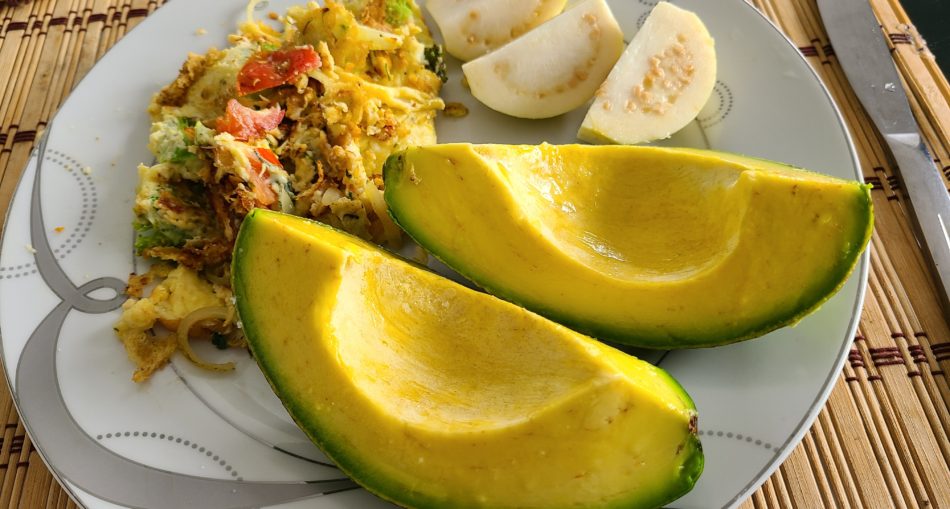The avocado is a fruit that is both delicious and healthy; this creamy, buttery fruit is super satisfying. It’s thick and smooth texture leaves your palate with a musky, milky taste.
The avocado tree (Persea americana) is classified as a member of the flowering plant family Lauraceae. The fruit of the plant is called an avocado/ avocado pear/ alligator pear; botanically, it is a large berry containing a single large seed known as a pit or a stone.
The avocado originated from South Central Mexico. It was discovered in the 15th century by the Spanish explorers to the New World. There are many species of avocado with almost almost 400 varieties around the world and 30 main cultivars. The three main ones are from Mexico, Guatemala, and the West Indies.
Avocados Grown in Guyana
It is a huge thing when the avocados are in season in Guyana; it is seen all over, in the markets, at the side of the roads in tubs/ on small stands and they are seen on a lot of trees in people’s backyard. The avocados grow bountifully in Guyana. They are grown in the Pomeroon, Linden-Soesdyke Highway, the Canals Polder on the West Demerara and in the North West District among other places.
How is the avocado grown?
The avocado is grown from the seed found in the fruit. Set the seed by pushing the blunt end into a pot with moist potting soil. The pointed end should be left exposed and leaves would grow within three to four weeks. When the tree is approximately 12 inches tall, the plant can be grafted.
Planting should be done during the wet season while there is an adequate supply of moisture for quick establishment of roots. When planting, the vigor and growth pattern of the trees should be considered. Those that have a spreading habit would require more space than upright types. Generally, plants are spaced 20-25 feet apart giving approximately 100-70 trees per acre.
Did You Know?
A standard tree would take approximately five years to bear fruit but a grafted one bears within three years.
Nutrients and Benefits of the Avocado
Avocados are rich in several B vitamins and vitamin K, they have good content of vitamin C, vitamin E and potassium. They also contain phytosterols and carotenoids, such as lutein and zeaxanthin.
Tip:
The avocado oil is rich in nutrients and has diverse uses for cooking, in cosmetics and soap products.
Benefits:
- Ongoing studies have shown that the high folate-content of avocado can help prevent strokes.
- For ages, the avocado fruit and its leaves have been used by many as folk medicine. Boil four of the dried leaves with 3 cups of water, cool it, refrigerate and then drink a little each morning for seven days straight. It works as a cleanser for the body as some say.
- Avocados are rich in fiber; fiber may have important benefits for weight loss and metabolic health.
- Avocados can lower cholesterol and triglyceride levels.
This video sums it up nicely!
Uses of the Avocado
Avocados can be cut in half, sprinkled with a little salt and eaten simply with a spoon. It can be eaten and used in other ways. Avocados can be added to any smoothie recipe to thicken it up, it can be used as a butter spread for bread, it can be made into guacamole (a dip made from avocados) and they can also be eaten in salads.
The avocado can be made into a face mask by taking one fully ripe fresh avocado, remove the skin as well as the seed, and mash it up into creamy pulp in a bowl. Then, add one tablespoon of honey and stir in honey until it turns into a uniform paste. Apply to skin and leave it on for 10-15 minutes. Rinse off the mixture with lukewarm water and pat dry your face with a soft towel.
The avocado can also be used as a hair mask by mashing the avocado and mixing honey, egg and essential oils. Apply this mixture to the hair and cover with a plastic shower cap or plastic wrap. Leave on for 15-20 minutes. Rinse well with lukewarm water and shampoo and condition as normal.
Note: The fruit darkens when exposed to air, to avoid this squeeze some lemon or lime juice over it.

Avocados Salad
Avocados in Guyana
The avocados do not ripen on the tree. When they are fully grown they are picked and left to ripen. This can take about 1 to 2 weeks; it can also be placed in a bag and left at room temperature to ripen. If the avocado is not ripe enough it will be hard but if it is too ripe then it will be mushy and brown on the inside. Press your thumb on the avocado, if it yields to the gentle pressure then it is ripe. Also, you can remove the little nub on top of the avocado to see the color underneath it; this will help you to determine if the avocado is ready to be eaten. The next time you pass an avocado in the market, supermarket, on the side of the road or in the backyard of someone, stop and ask to pick it or buy it and experience the multi-benefits of this superfruit in Guyana. Find out for yourself how delicious and healthy they are.
Article References:
- https://www.stabroeknews.com/2017/sunday/in-the-garden/07/30/grow-your-own-avocadoes/
- https://www.stabroeknews.com/2011/the-scene/02/19/avocado-a-misunderstood-fruit/
- http://www.beauteous.co.nz/beauty-advice/beauty-tips/4-homemade-avocado-face-mask-recipes/
- https://www.healthline.com/nutrition/12-proven-benefits-of-avocado
- https://spoonuniversity.com/lifestyle/what-does-avocado-taste-like
- https://en.wikipedia.org/wiki/Avocado
- http://agriculture.gov.gy/wp-content/uploads/2016/01/avocado.pdf







